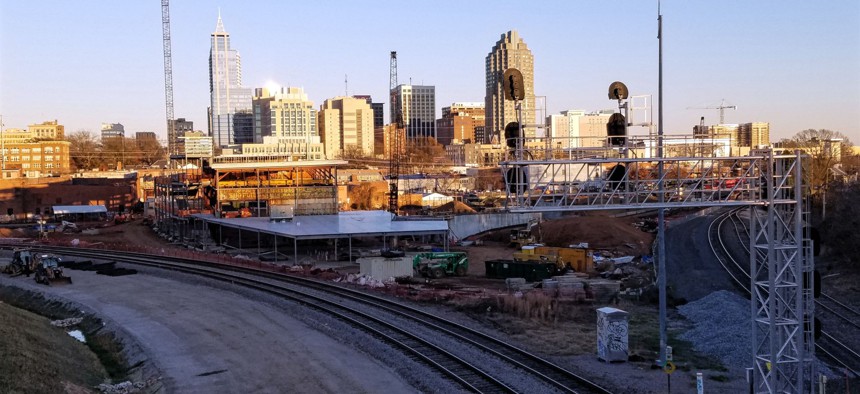Route Fifty Roadmap: Raleigh’s New Union Station Starts to Take Shape

Raleigh's future multi-modal transportation center is taking shape at this railroad wye on the edge of downtown. Michael Grass / RouteFifty.com
Incremental infrastructure improvements are laying the foundation for a bigger future in North Carolina’s capital city.
Route Fifty Roadmap is an ongoing series of dispatches from the semi-regular travels of the Route Fifty staff around the United States. | PREVIOUSLY: Leawood, Kansas
RALEIGH, N.C. — While President Obama’s ambitious vision to develop a national high-speed rail network didn’t exactly materialize during his administration, there have been some measured, incremental victories if you know where to look for them. It’s a subject I’ve explored previously for Route Fifty: Through track upgrades, for instance, Amtrak service between Chicago and Detroit now accommodates 110 mph speeds.
That’s a far cry from true high-speed service as seen in Asia and Europe, but slowly but surely, improvements to tracks and signaling are beginning to pay off as bottlenecks are eliminated and travel times decrease along rail corridors in the Midwest, Pacific Northwest and elsewhere.
Here at the edge of downtown Raleigh, another incremental infrastructure victory is starting to take shape. Construction of Raleigh’s new passenger rail station is well underway, adjacent to a railroad wye that will, someday, become one of the most important transportation junctions in the North Carolina.
A year ago when I visited Raleigh, there wasn’t much going on at the site where Union Station is now rising around a repurposed warehouse building that had been stagnating among overgrowing weeds.

The site now hums with the sounds of construction as the first phase of the new 26,000-square-foot facility rises.

Ground was broken in May 2015 and the facility is currently scheduled to open by the first quarter of 2018. The $90 million costs are being shared by the city of Raleigh, the state of North Carolina and the federal government, which awarded U.S. Department of Transportation TIGER grants for the project’s construction.

While critics, including many Republican governors, have questioned the value of the Obama administration’s transportation investments, the Raleigh project that's underway has benefits despite not delivering high-speed rail service.
There are the near-term benefits:
- First, and foremost, Raleigh’s aging rail station on Cabarrus Street, currently one of the busiest in the Southeastern U.S., will be replaced with a facility that will serve as an intermodal transit hub for North Carolina’s capital.
- Areas adjacent to the new Union Station, including Raleigh’s revitalized Warehouse District, will see continued investment, including a 17-story office building that’s currently under construction.

There are medium-term benefits:
- The future Raleigh Union Station will lay the foundation for future commuter rail service in the Raleigh-Durham area. In November, voters in Wake County, which includes Raleigh, approved a proposal to fund transit improvements in the area, including upgrades to existing bus service and the creation of bus rapid transit corridors and commuter rail. Those commuter rail trains will service new platforms at Raleigh Union Station.
The long-term benefits are harder to identify, but boil down to this:
- If there’s a major investment in high-speed rail in the Southeastern United States down the road, the Union Station footprint will have laid the foundation to accommodate those trains. Currently, Amtrak service between North Carolina’s capital and Richmond, must travel indirectly via Rocky Mount, Selma and Wilson, in eastern North Carolina. But if tracks are rebuilt along an existing right of way running north from Raleigh and roughly parallel to Interstate 85 in southern Virginia, travel times from North Carolina’s capital to Richmond and Washington, D.C., could be reduced significantly.
So while the Obama administration's grand vision of regional high-speed rail networks will not likely materialize for years and years—unless President-elect Trump’s promised massive infrastructure investment injects the nation’s passenger rail program with new resources—the first phase of Raleigh’s Union Station is an important step in that direction.
And this time next year, as construction begins to wrap up, that importance of taking that first major step will become self-evident.

Michael Grass is Executive Editor of Government Executive’s Route Fifty and is based in Seattle.
NEXT STORY: What’s to Be Done About Confederate Monuments in New Orleans?






